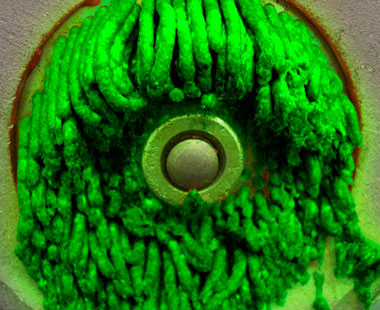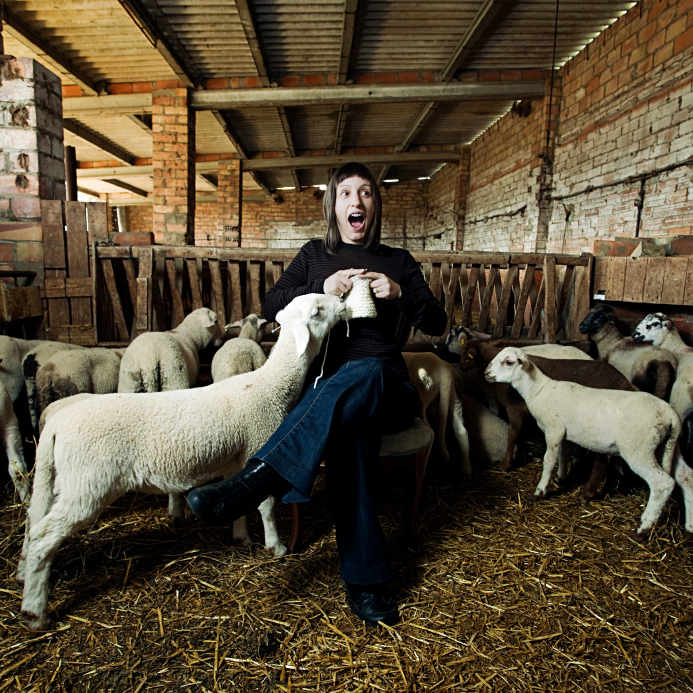Modern homesteading can be particularly maddening for the ladies.
Cross-posted from The Last Word on Nothing.
There are a lot of ways to shrink a carbon footprint. Bike instead of drive. Eat low on the food chain. You know the drill. Where I live, in the boondocks of Colorado, a lot of people — myself included, but I’ll get to that in a minute — go on a carbon diet by purchasing some cheap land, rigging up a few solar panels, and getting off the grid.
Most of these people are well-educated, well-meaning, and idealistic, determined to build and garden their way toward some version of a better future. But after living here for more than a decade, I’ve noticed a disturbing susceptibility among these modern homesteaders. I’ll call this recurring disease Not One More Winter In The Tipi, Honey (NOMWITTH).
Here’s what happens: A couple arrives in our valley, young, strong, in love, and full of plans to build an ultra-energy-efficient house out of straw bales, rammed earth, adobe bricks, or, heck, used bottlecaps. They set to work with equal enthusiasm, buying land and setting up temporary quarters in a yurt or a tipi. The weather’s good, the views are great, and the new house is humming along.
But at some point, the weather turns, or the project slows. Or a baby arrives, and everything gets more complicated. For whatever reason, their brio fades, NOMWITTH sets in, and what was once a joint project becomes a battlefield, XX vs. XY. In mild cases, help is hired, the house gets a roof, and all ends well. In more serious cases, one person — inevitably XX — splits town for a fully furnished condo with central heating, leaving XY alone with the low-carbon dream.
I’ve seen many couples, and carbon budgets, fall prey to NOMWITTH, and the predictability of its gender roles has always bothered me. Women may have different strengths than men, but we don’t lack for toughness — we demonstrate that in feats ranging from mountain climbing to childbirth. So why does NOMWITTH always seem to strike women first?
Of course, every household is different, and I don’t presume to know exactly what goes on in anyone else’s. But I do wonder if this predisposition to NOMWITTH has historical and cultural roots.
Many scholars — notably Ruth Schwartz Cowan, in her classic book More Work for Mother — have pointed out that the early-20th century revolution in household technology, despite its many promises, didn’t actually save middle-class women any time. Washing machines meant that people hired fewer servants, had larger wardrobes, and washed their clothes more frequently. Vacuum cleaners led to higher standards of carpet cleanliness. Yet these inventions did change the nature of household work, rescuing women of all classes from at least some of its sweaty, undervalued drudgery.
Too often, modern homesteading asks women to return to the toil so many of their grandmothers left behind. No matter how progressive the homesteading couple, the unfamiliarity and the physical demands of DIY living make it easy to fall into traditional gender roles — to retreat to the stereotypically masculine and feminine skills most of us still learn first and best. The result is that in many modern homesteads, despite highly evolved intentions, men build the houses, and women, like their pioneer-era counterparts, cook over the wood stove. Or scrub the floors. Or care for the babies.
This old-fashioned division of labor means that women are often the first to encounter the worst realities of homesteading. While their partners are outside, impressing the neighborhood with their construction skills, women are inside, confronting the cultural invisibility of domestic work and the social isolation of rural life. Both are working hard, but one gets more public props than the other. Put another way, it doesn’t take too many solo rounds of hand-washing dirty diapers to kill the romance of modern homesteading, and bring on critical NOMWITTH.
I’d advise NOMWITTH sufferers and their partners to strictly moderate their expectations of themselves and others, and monitor their personal ideologies for signs of calcification. Except for a constant watch on domestic divides, though, I don’t think there’s any reliable way to avoid NOMWITTH — but for dumb luck and good timing, I, too, might have fallen victim to a terminal case.
When I met my husband-to-be here in Colorado, he had, conveniently, just finished work on a 600-square-foot house insulated by straw bales, powered by solar panels, and equipped with a healthy supply of rainwater for hot showers. When we moved in together, I got to enjoy the genuine fun of modern homesteading (dining under the stars, living dirt-cheap) with very little of the drudgery (don’t get me started on the composting toilet, okay?). Because our basic needs — for, say, a roof — were already met, I got to keep the professional career that my feminist mother and my suburban childhood had raised me to expect.
When we had our daughter, we chose cloth diapers, but we also enlisted some help from technology — we bought a low-water washing machine compatible with our power system. And while we bicker about laundry duties like any other couple, it’s assumed that both of us, with roughly equal frequency, will wash the damn diapers.
Begone, NOMWITTH.



